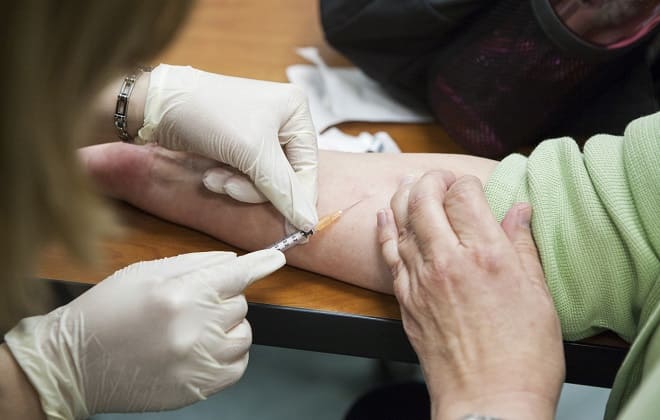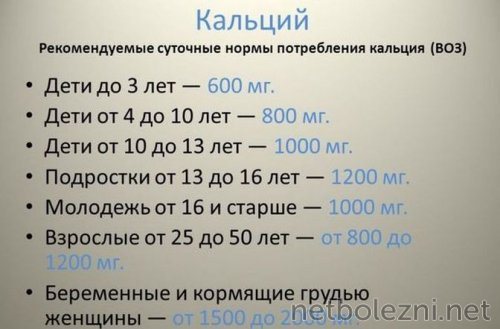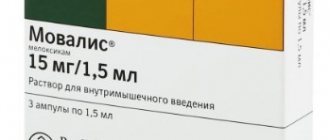Calcium gluconate is a pharmacological drug that is calcium salts of gluconic acid and is produced in the form of a liquid solution for intravenous and intramuscular administration. Injections are prescribed to normalize calcium-phosphorus metabolism, stimulate hematopoiesis and treat many diseases.
Compound
One tablet may contain 250 or 500 mg of active substance.
Auxiliary components: potato starch, anhydrous silicon dioxide in colloidal form, calcium stearate.
The concentration of the active substance in 1 ml of solution is 95.5 mg. 1 ml of the drug contains 8.95 mg of total calcium (Ca2+), which in terms of the theoretical content of calcium gluconate is 100 mg/ml. The solution contains calcium sucrose and water as auxiliary components.
Doses
The daily or monthly dosage of the drug is selected individually for each patient. Only an experienced doctor can correctly determine the required amount of solution, so it is not recommended to self-medicate. The dosage of the solution depends on the following parameters:
- degree of danger of the disease;
- patient's gender;
- age;
- body mass;
- stage of disease development.

Most often, doctors prescribe 5 to 10 ml of solution for adults and 1-5 ml for children. In both cases, only 1 injection per day is allowed. If gluconate is used to maintain Ca levels in the blood, then the frequency of injections is once every 2 or 3 days.
Pharmacodynamics and pharmacokinetics
Calcium gluconate - what is it?
Calcium gluconate is a mineral supplement that is used to treat conditions caused by calcium deficiency in the body. The calcium content in the preparation is 9%. The INN (Calcium gluconate) was assigned to the active substance based on data from the European Pharmacopoeia (Ph.Eur.).
the myocardium cannot function normally , contraction of smooth and skeletal muscles, and blood clotting processes; Without them, bone tissue cannot form normally, and other organs and systems cannot function.
The gross formula of calcium gluconate is C12H22CaO14.
Pharmacodynamics
In many diseases, the concentration of Ca ions in the blood decreases; at the same time, severe calcium deficiency contributes to the development of tetany. The drug not only prevents the occurrence of hypocalcemia , but also reduces the permeability of vascular walls, relieves inflammation, has an antiallergic and hemostatic effect , and reduces exudation.
Ca ions are a plastic material for teeth and skeleton; many enzymatic processes occur with their participation; they are responsible for regulating the permeability of cell membranes and the speed of transmission of nerve impulses.
They are needed for the process of neuromuscular transmission and maintaining the contractile function of the heart muscle. If we compare calcium gluconate with calcium chloride, the latter has a more pronounced local irritating effect.
Pharmacokinetics
When taken orally, the substance is partially absorbed, mainly in the small intestine. TCmax - 1.2-1.3 hours. T1/2 of ionized Ca from blood plasma - from 6.8 to 7.2 hours.
Penetrates into breast milk and through the placental barrier. It is excreted from the body mainly by the kidneys, but also with the contents of the intestines.
Indications for use of Calcium gluconate
What is Calcium Gluconate tablets for?
Tablets are recommended for conditions accompanied by hypocalcemia, increased permeability of cell membranes, and disturbances in the conduction of nerve impulses in muscle tissue.
Doctors answer the question “what is calcium gluconate used for?” answer that the use of the drug is advisable for:
- hypoparathyroidism ( osteoporosis , latent tetany);
- vitamin D metabolism ( spasmophilia , rickets , osteomalacia );
- hyperphosphatemia in patients with chronic renal failure;
- increased need for Ca ( pregnancy , breastfeeding , periods of intensive growth in children/adolescents);
- insufficient Ca content in the diet;
- bone fractures;
- Ca metabolism disorders in the postmenopausal period;
- conditions that are accompanied by increased excretion of Ca (chronic diarrhea , prolonged bed rest; long-term treatment with diuretics , corticosteroids or antiepileptic drugs );
- poisoning with oxalic acid, Mg salts, soluble salts of fluoric acid (the advisability of using the product as an antidote is due to the fact that, interacting with these substances, Ca gluconate forms non-toxic Ca oxalate and Ca fluoride).
As an addition to the main treatment, calcium gluconate tablets are used as an allergy remedy for itchy dermatoses , febrile syndrome , urticaria , serum sickness , angioedema ; for bleeding of various origins, nutritional dystrophy , bronchial asthma , pulmonary tuberculosis , hepatitis , eclampsia , nephritis , toxic liver damage .
Why are calcium gluconate injections used?
Calcium gluconate in ampoules is prescribed for certain pathologies of the parathyroid glands , conditions that are accompanied by increased excretion of Ca from the body, as an adjuvant for allergies , as well as for allergic complications of treatment with other drugs, to reduce vascular permeability in various types of pathological processes, for nephritis , eclampsia , liver intoxication , hyperkalemia , parenchymal hepatitis , hyperkalemic form of periodic paralysis ( paroxysmal myoplegia ), as a hemostatic agent.
Indications (intravenously/intramuscularly) for administration of the drug are also poisoning with soluble salts of fluoric acid, oxalic acid or Mg salts, for skin diseases ( psoriasis, itching, eczema ).
In some cases, Calcium gluconate is used during autohemotherapy . This method of treatment has proven itself well for skin diseases, furunculosis , recurrent colds , diabetes , rheumatism , allergies , and during the recovery period after serious illnesses.
10 ml of calcium gluconate solution is injected into the patient's vein, and then blood is immediately taken from the vein and transferred back in the form of a subcutaneous injection or injection into the gluteal muscle.
What is a hot shot?
Injections of the drug are also known as “hot injections of calcium gluconate.” In fact, the solution is administered heated only to body temperature.
A hot injection is called a hot injection because of the subjective sensations that arise in the patient: after the injection, there is usually a feeling of warmth spreading throughout the body, and sometimes a fairly strong burning sensation.
Calcium gluconate for allergies
Doctors have proven that one of the causes of allergies may be a severe calcium deficiency in the body. It is with Ca deficiency that most allergic reactions in children are associated: the child’s body grows very rapidly, and as a result, the Ca content in all its tissues decreases.
In addition, factors that contribute to the formation of Ca deficiency are excess vitamin D in the body and teething.
, calcium gluconate is often used as one of the methods for preventing and treating allergies
With sufficient calcium intake into the body, the permeability of the vascular walls decreases, and the penetration of allergens into the systemic bloodstream becomes more difficult. This means that an increase in Ca concentration is accompanied by a decrease in the likelihood of an acute immune reaction.
Calcium gluconate is used in combination with antihistamines . The drug is prescribed, among other things, to eliminate side effects caused by taking other medications.
Studies have shown that, as a source of calcium alone for the body, the calcium salt of gluconic acid is the least active, however, calcium gluconate is best suited allergic diseases
The tablets are taken orally before meals. The dose depends on the characteristics of the disease and the age of the patient.
In addition, in some cases, the patient may be prescribed intravenous administration of the solution. allergies , calcium gluconate is not recommended to be administered intramuscularly or subcutaneously (especially to children).
The course of treatment for allergies usually lasts from 7 to 14 days.
Calcium gluconate for allergies (reviews are eloquent confirmation of this) is a time-tested and quite effective remedy, which, on top of everything, is almost impossible to overdose on.
Maximum absorption of calcium is ensured with the participation of vitamin D , amino acids (in particular L-arginine and lysine) and Ca-binding protein.
Use against allergies
Intravenous injections of calcium gluconate are prescribed for severe forms of allergies or intoxication of the body, including food, medicinal and chemical. Due to its wide spectrum of action, the drug is used for complicated allergic reactions accompanied by extensive urticaria, bronchial asthma, dermatitis, fever and Quincke's edema.
The pharmacological agent is prescribed in the complex treatment of allergic reactions of various types to seal and strengthen the walls of blood vessels. The drug increases their tone and elasticity, normalizes permeability, stopping the penetration of the allergen into the body.

The active substance has a pronounced antihistamine effect, improving the condition of connective tissue cells. This speeds up recovery from allergies and reduces unpleasant symptoms of the disease.
When treating allergies, the drug is administered intravenously, the so-called “hot” injection. The injection is most often well tolerated by a person, but when performed on an empty stomach, weakness, dizziness and even fainting may occur. Therefore, you must eat before administering the medicine.
Contraindications
Contraindications to the use of solution and tablets:
- intolerance to the components of the drug;
- severe hypercalciuria ;
- tendency to thrombosis;
- hypercoagulability;
- severe atherosclerosis ;
- calcium nephrourolithiasis;
- increased blood clotting;
- sarcoidosis;
- severe renal failure;
- period of treatment with cardiac glycosides (for example, digitalis preparations).
Treatment of bleeding and diseases of the cardiovascular system
Calcium is a trace element that is directly involved in the process of blood clotting. Therefore, with prolonged bleeding, the amount of this substance in the blood rapidly decreases.
Intravenous or intramuscular injections with calcium gluconate quickly normalize the level of the trace element in the blood, raising it to the required level. This improves blood clotting and helps stop prolonged bleeding, including internal bleeding.
The drug is widely used for various pathologies of the vascular system. It normalizes the permeability of blood capillaries and stimulates contractions of vascular smooth muscle tissue.

This leads to a decrease in the clearance between these tissues, which significantly complicates the penetration of toxic substances, allergens and pathogens into the blood. Before using injections, it is necessary to take into account existing contraindications. If you are prone to vascular thrombus formation, the use of the medicinal solution is prohibited.
Side effects
The drug is usually well tolerated, but in some cases the following disorders are possible:
- bradycardia;
- hypercalciuria , hypercalcemia ;
- nausea, vomiting, stool disorders ( constipation /diarrhea), epigastric pain;
- formation of calcium stones in the intestines (with long-term use of high doses of the drug);
- impaired renal function ( swelling of the lower extremities, frequent urination);
- hypersensitivity reactions.
bradycardia , diarrhea, a feeling of heat in the mouth and then throughout the body, and changes in the skin may sometimes be observed These reactions pass quite quickly and do not require special treatment.
sweating , vomiting, arterial hypotension , and collapse (in some situations, lethal) may occur The result of extravasal penetration of the solution can be calcification of soft tissues.
In very rare cases, allergic and anaphylactic reactions .
When calcium gluconate is administered intramuscularly, local irritation and tissue necrosis .
Instructions for use of Calcium gluconate
Calcium gluconate tablets, instructions for use
The tablets are taken before meals, after crushing or chewing.
A single dose for patients over 14 years of age is from 1 to 3 g (2-6 tablets for each dose). Patients 3-14 years old are given 2-4 tablets. 2-3 rubles/day.
Treatment lasts from 10 days to 1 month. The duration of the course is determined by the attending physician individually depending on the patient’s condition.
The permissible upper limit of the daily dose for elderly patients is 4 tablets. (2 g).
Ampoules Calcium gluconate, instructions for use
Calcium gluconate is administered intravenously or intramuscularly.
For patients over 14 years of age, injections are given once a day. A single dose is from 5 to 10 ml of solution. Depending on the patient’s condition, injections can be given daily, every other day or once every two days.
For children from birth to 14 years of age, the dose of 10% calcium gluconate solution intravenously varies from 0.1 to 5 ml.
Before administration, the drug should be warmed to body temperature. The medicine should be administered slowly - over 2-3 minutes.
To administer less than one milliliter of solution, it is recommended to dilute a single dose to the required volume (syringe volume) with a 5% glucose solution or 0.9% NaCl solution.
Injections for kidney and liver diseases
Intravenous or intramuscular injections with calcium gluconate can be used in the complex treatment of intoxications of various origins. In case of poisoning, toxic substances affect the liver and accumulate in it, disrupting its normal functioning.
Liver intoxication is manifested by painful spasms in the right side, convulsions, increased body temperature, increased sweating, and a yellow tint to the whites of the eyes and skin. A person feels general weakness, lethargy, loss of strength and malaise.

Calcium gluconate, used in the form of intravenous or intramuscular injections, increases the level of this trace element in the blood. This has a positive effect on metabolic processes, accelerates the removal of harmful waste and toxic substances from the body, and increases the immune barrier to protect against irritants.
The use of this pharmacological agent helps to normalize the balance of electrolytes in the blood. That is why calcium gluconate is often used in the complex treatment of nephritis and other chronic diseases of the liver and kidneys.
Overdose
With long-term treatment with high doses of calcium gluconate, the risk of developing hypercalcemia with the deposition of Ca salts in the body increases. The likelihood of hypercalcemia increases with the simultaneous use of high doses of vitamin D or its derivatives.
Hypercalcemia manifests itself:
- anorexia;
- constipation;
- nausea/vomiting;
- irritability;
- increased fatigue;
- polyuria;
- abdominal pain;
- polydipsia;
- muscle weakness;
- arterial hypertension;
- arthralgia;
- mental disorders;
- kidney stones;
- nephrocalcinosis.
In severe cases, coma and cardiac arrhythmia .
To eliminate the symptoms of overdose, the drug should be discontinued. In severe cases, the patient is prescribed intravenous calcitonin at a rate of 5-10 MO/kg/day. The product is diluted in 0.5 liters of 0.9% NaCl solution and administered dropwise over six hours. Slow drip administration of the antidote 2-4 times a day is also allowed.
Interaction
A drug:
- slows down the absorption of etidronate , estramustine , bisphosphonates , tetracycline antibiotics , quinolones , fluoride and iron preparations for oral administration (an interval of at least 3 hours should be maintained between their doses).
- reduces the bioavailability of phenytoin ;
- enhances the cardiotoxicity of cardiac glycosides ;
- in patients with hypercalcemia , it reduces the effectiveness of calcitonin ;
- reduces the effects of calcium channel blockers;
- increases the toxicity of quinidine .
In combination with quinidine, it provokes a slowdown in intraventricular conduction; in combination with thiazide diuretics hypercalcemia increases . Vitamin D and its derivatives help increase calcium absorption. Cholestyramine reduces Ca absorption in the gastrointestinal tract.
Forms insoluble or slightly soluble Ca salts with salicylates, carbonates, and sulfates.
Certain foods (for example, rhubarb, bran, spinach, cereals) can reduce the absorption of Ca from the digestive tract.
Not compatible with the solution:
- carbonates;
- sulfates;
- salicylates;
- ethanol.
special instructions
Due to the possibility of developing necrosis, calcium gluconate should be administered exclusively intravenously to children under 14 years of age.
Before filling the syringe, ensure that there is no residual alcohol in it (a sediment may form).
Treatment of patients with of urolithiasis , reduced glomerular filtration rate or mild hypercalciuria should be carried out under the control of Ca2+ levels in the urine. To reduce the risk of developing urolithiasis, it is recommended to drink enough fluids.
“Pharaoh's snake” from calcium gluconate
Calcium gluconate tablets are often used by enthusiastic chemists to produce “pharaoh’s snake,” a porous product that is formed from a small amount of reacting substances.
The tablet is placed on dry fuel, and then the fuel is set on fire. A light gray “snake” with white spots begins to crawl out of the tablet. Moreover, the volume of the “pharaoh snake” significantly exceeds the volume of the original substance: for example, in some experiments, snakes 10-15 cm long were obtained from 1 tablet.
During the decomposition of calcium gluconate, Ca oxide, carbon dioxide, carbon and water are formed. The characteristic shade of the resulting snake is given by Ca oxide. The only drawback of such a “pharaoh snake” is its fragility; it crumbles very easily.
Rules for using injections
For all injections, both general rules and specific ones apply, which depend on the characteristics of the administration of the drug.
When prescribing intravenous calcium injections, it is very important to follow all the rules of asepsis. This will prevent the introduction and development of various infections. Before using the drug, the injection site must be disinfected with alcohol or hydrogen peroxide.
When drawing a solution for intravenous injection into a syringe, you need to expel all bubbles from it. Even a small air bubble entering a vein will lead to blockage of the vein and the death of the patient.
Calcium gluconate is administered very slowly over 2-3 minutes. Giving the medication too quickly can lead to low blood pressure, arrhythmia, and death.
At the end of the manipulation, the patient needs to squeeze a cotton swab soaked in alcohol or hydrogen peroxide in the elbow bend to prevent bruising at the injection site.
Calcium gluconate injections are injected intramuscularly in accordance with the following rules:
- The drug can be injected exclusively into the gluteal muscle. This place, due to a fairly thick layer of muscle, allows doctors to inject patients without pain;
- Before the injection, you need to thoroughly treat the surface of the skin with an antiseptic. Otherwise, infection may occur with dangerous consequences, including tissue necrosis;
- When filling the syringe, make sure that no alcohol remains in it. It causes the formation of sediment;
- as with intravenous administration, it is important to observe the rate of delivery of the drug so that the injection takes place without undesirable consequences.
During a course of treatment with calcium gluconate, strict monitoring of the level of electrolytes in the blood is carried out in order to timely track the moment when injections should be stopped and not to increase the electrolyte level above normal. Such monitoring will help avoid overdose, which manifests itself in the following symptoms:
- disorders in the gastrointestinal tract. May manifest as nausea, vomiting, and constipation;
- sharp abdominal pain;
- muscle weakness;
- frequent urination;
- increased blood pressure;
- the person experiences extreme thirst, dry mouth;
- the patient becomes overly irritable and gets tired quickly.
An overdose of calcium gluconate leads to the formation of kidney stones.
In order to avoid such consequences, patients are prescribed injections of 5-10 milliliters of a 10 percent solution daily, every other day, and sometimes every two days.
Hypercalcemia (overdose) is an indication for the use of infusion of calcitonin (5-10 IU per kilogram of body weight), diluted in a 0.9 percent sodium chloride solution.
A “hot” injection is nothing more than the injection of a calcium gluconate solution into a vein. In fact, it's just an expression. In no case is the drug heated to a hot state, it is heated to the patient’s body temperature, while the patient himself feels the heat spreading throughout the body. That’s why calcium gluconate injections are called “hot”.
As described in the instructions for use, calcium gluconate injections are absorbed quickly by the intestines, penetrating into the blood and taking on a bound ionized state. The most active is ionized calcium, which enters the bone tissue. The drug is excreted from the body in feces and urine.
The solution, both intramuscularly and intravenously, must be administered very carefully and slowly – 2-3 minutes. Adults are prescribed 10% calcium gluconate daily or every other day; the dosage for children intravenously is from 1 to 5 ml. They are given injections once every 2-3 days. The need for careful execution lies in the possibility of developing soft tissue necrosis, which requires emergency medical attention.
If the patient has mild hypercalciuria or nephrourolithiasis has been diagnosed, the drug is administered under the control of calcium levels in the urine. With this attitude, you can keep the absorption of calcium in the body under control. To prevent the risk of developing urolithiasis, the patient should drink plenty of water.
Analogs
Level 4 ATC code matches:
Calcium Sandoz Forte
Calcium glycerophosphate
Calcium gluconate-Vial , LekT , B. Brown ; Additive calcium , Hydroxyapatite , Glycerophosphate granules , Calcium lactate , CalViv , Calcium pangamate , Calcium-Sandoz .
Calcium gluconate for children
Why is calcium gluconate prescribed to children?
In the articles, Dr. Komarovsky notes that the most common indications for the use of the drug in pediatrics are conditions caused by insufficient intake of calcium into the body from food, as well as conditions caused by impaired absorption of calcium in the intestine.
Hypovitaminosis D to the development of hypocalcemia , along with a reduced content of Ca in food . In addition, certain diseases of the parathyroid glands and thyroid gland hypocalcemia .
In addition to these diseases and rickets , indications for prescribing Ca drugs for children are allergic diseases (acute or chronic), skin diseases, pathologies manifested by blood clotting disorders, physiological conditions that are accompanied by an increase in the child’s body’s need for Ca (periods of active growth).
How to take Calcium Gluconate correctly?
For children, Komarovsky recommends dosing calcium gluconate depending on age. In the first 12 months of a child’s life, the standards for daily Ca intake range from 0.21 to 0.27 g. Children under 3 years of age require 0.5 g of Ca per day, children 4-8 years old - 0.8 g, children over eight years of age - 1-1.3 g.
As a rule, children get Ca from dairy products, greens, fruits, vegetables and nuts.
Children under 12 months are given 3 tablets per day (1.5 g), children under 4 years old - 6 tablets per day (3 g), children under 9 years old - depending on the severity of calcium deficiency and the characteristics of the clinical situation - 6-12 tablets. day (3-6 g), children under 14 years old - 12-18 per day (6-9 g).
The daily dose is divided into 2-4 doses.
The drug is usually administered intravenously to children as an emergency treatment: for bleeding, convulsions, acute allergic reactions.
The solution is not administered subcutaneously or intramuscularly to children. Medicine can only be injected into the muscle in adult patients!
Normalization of vitamin balance
Calcium gluconate is used to normalize the vitamin balance in the body. Calcium is actively involved in the complete absorption of vitamin D. That is why the pharmacological agent is prescribed to strengthen tooth enamel and bone elements of the skeleton, to alleviate the condition of the child during teething, treatment and prevention of rickets.
Injections with the drug are often prescribed to women during pregnancy, breastfeeding or menopause, since against the background of hormonal changes in the body, the need for calcium increases significantly. The drug is also widely used for children during the period of active growth.
Calcium gluconate is used to normalize the content of microelements in the human bloodstream. That is why the drug is often used for prolonged bouts of vomiting or diarrhea. In such cases, along with the fluid, the body loses a large amount of calcium and other useful elements.

Injections are prescribed in conjunction with dehydrating medications (Regidron, Trihydrosol), which help normalize the water and electrolyte balance in the body and improve the functioning of the digestive, nervous and cardiovascular systems.
Reviews of Calcium gluconate
The most common reviews of the drug Calcium Gluconate are reviews for allergies . The drug is prescribed to both adults and very young children. At the same time, most people consider it a worthy alternative to more expensive and advertised medications.
To compensate for calcium deficiency, tablets are usually prescribed, but in some situations the drug is administered intravenously or into a muscle.
Reviews of calcium gluconate injections intramuscularly suggest that the procedure is quite painful. Moreover, unpleasant sensations usually occur not during the injection, but after it.
Reviews about calcium gluconate intramuscularly indicate that intravenous injections are tolerated somewhat easier than injections into the muscle. However, it should be remembered that the injection is “hot”, and after it you should not stand up suddenly.
Despite the pain of injections, the drug helps well with allergies , pityriasis rosea , heavy periods, persistent sore throat , herpes and a number of other pathologies. In pregnant women, after treatment with calcium gluconate, leg cramps are significantly reduced, nails and teeth are strengthened.
However, you should not forget that the product is a medical drug, so only a doctor can recommend treatment for it.
The use of injections for children and pregnant women
For children, injections with the drug are prescribed during the period of active growth and development. It strengthens bone tissue and tooth enamel, ensures their proper development, and also facilitates the child’s condition during teething.
Calcium gluconate is used to treat many diseases - colds, serum sickness, various allergic reactions, urticaria, problems with vascular permeability.
Children are most often prescribed a pharmacological drug in the form of tablets that need to be taken orally, in severe cases - intravenous injections. Intramuscular injections for children are prohibited.
The drug has found wide use in restoring calcium balance in pregnant women. The body of the expectant mother often loses a large amount of calcium, which is “wasted” on the development of the fetus. As a result, the woman’s general well-being and appearance deteriorate.

Most often, calcium gluconate is prescribed in tablet form during pregnancy. If it is necessary for the pharmacological agent to quickly penetrate the woman’s blood, intravenous or intramuscular injections can be prescribed.
Calcium gluconate price
The price of Calcium gluconate tablets in Russian pharmacies is from 3.5 rubles. for 10 pieces. The cost of package No. 30 is 40-45 rubles. In Ukraine you can buy 10 tablets from 3.85 UAH.
A 10% solution in Ukrainian pharmacies costs from 17 UAH (5 ml ampoules, No. 10). The price of an ampoule of 5 ml (No. 1) is 1.8 UAH. In Russia, the price of Calcium gluconate injections is from 118 rubles.
- Online pharmacies in RussiaRussia
- Online pharmacies in UkraineUkraine
- Online pharmacies in KazakhstanKazakhstan
ZdravCity
- Calcium gluconate tablets 500 mg 20 pcs Pharmstandard-Leksredstva OJSC
32 rub. order - Calcium gluconate-SOLOpharm solution for IV and IM 100 mg/ml (amp) 5 ml 10 pcs. Grotex LLC
102 RUR order
- Calcium gluconate tablets 500 mg 30 pcs. AO Update PFK
43 RUR order
- Calcium gluconate solution for intravenous and intramuscular administration. 100 mg/ml, 10 ml, 10 pcs. Grotex LLC
RUB 193 order
- Calcium gluconate tablets 500 mg 40 pcs JSC "PFK Obnovlenye"
54 RUR order
Pharmacy Dialogue
- Calcium gluconate (500 mg tablet No. 10)Update of PFC JSC
13 rub. order
- Calcium gluconate (amp. 10% 10ml No. 20)Braun
RUB 341 order
- Calcium gluconate-SOLOpharm (amp. 10% 10ml No. 10)Grotex LLC
RUB 174 order
- Calcium gluconate-SOLOpharm (amp. 10% 5ml No. 10)Grotex LLC
96 RUR order
- Calcium Gluconate tablets 500 mg No. 10 Square C
18 rub. order
show more
Pharmacy24
- Calcium gluconate 10% 5 ml No. 10 solution PAT "Farmak", Ukraine
28 UAH. order - Calcium gluconate-Darnitsa 10% 5 ml No. 10 injection solution PrAT” Pharmaceutical company “Darnitsa”, Ukraine
29 UAH order
- Calcium gluconate 0.5 No. 10 tablets PAT "Kiivmedpreparat", Ukraine/PAT "Galichfarm", Ukraine
6 UAH order
- Calcium gluconate 0.5 N10 tablets PAT "Lubnipharm", Ukraine
2 UAH order
- Calcium gluconate 10% 10 ml No. 10 solution PAT "Farmak", Ukraine
45 UAH order
PaniPharmacy
- Calcium gluconate stabil. solution d/in. 10% amp. 5ml No. 10 Ukraine, Darnitsa
34 UAH order
- Calcium gluconate solution d/in. 10% amp. 5ml No. 10 Ukraine, Darnitsa ChAO
15 UAH order
- Calcium gluconate tab. 0.5g No. 10 Ukraine , Health
4 UAH order
- Calcium gluconate tab. 0.5g No. 10 Ukraine, Lubnyfarm
3 UAH order
- Calcium gluconate stabilized. solution d/in. 100mg/1ml 5 ml No. 10 Ukraine, Farmak OJSC
23 UAH order
show more







